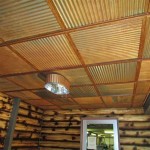Ceiling Designs For Small Living Rooms: Maximizing Space and Style
The ceiling, often overlooked in interior design, plays a critical role in defining the character and perceived spaciousness of a room. This is especially true in small living rooms, where every design element must contribute to optimizing the limited space. Thoughtful ceiling designs can visually expand a small living room, enhance its aesthetic appeal, and improve its overall ambiance. This article explores various ceiling design strategies suitable for small living rooms, focusing on techniques that maximize perceived height, introduce visual interest, and complement the room's existing décor.
Choosing the right ceiling design for a small living room requires careful consideration of factors such as ceiling height, lighting requirements, and the overall style of the room. A poorly chosen design can make the room feel cramped and claustrophobic, while a well-executed design can transform it into a comfortable and inviting space. The subsequent sections will discuss specific design options and considerations to guide homeowners in selecting the most appropriate ceiling design for their small living room.
Optimizing Height with Color and Texture
One of the simplest and most effective ways to make a small living room feel larger is to visually increase the ceiling height. Color plays a crucial role in this endeavor. Opting for a lighter color for the ceiling than the walls creates the illusion of height. White is a classic and universally applicable choice, as it reflects light effectively and creates an airy feel. Other light, neutral colors such as off-white, cream, or pale gray can also be used to achieve a similar effect. The key is to ensure that the ceiling color is noticeably lighter than the wall color, creating a sense of vertical expansion.
Beyond color, texture can also be used to enhance the perception of height. Smooth, reflective surfaces tend to visually recede, making the ceiling appear higher. Conversely, heavily textured surfaces can draw the eye down, making the ceiling feel lower. Therefore, for small living rooms, it is generally advisable to avoid heavily textured ceiling finishes such as popcorn ceilings or heavily patterned wallpaper. Instead, opt for smooth paint finishes or subtle textures that do not detract from the overall sense of height.
Another technique to consider is painting the ceiling with a glossy finish. A high-gloss finish reflects more light, making the ceiling appear brighter and more expansive. This is particularly effective in rooms with limited natural light, as it can help to brighten the space and create a more open feel. However, it is important to note that glossy finishes can also highlight imperfections, so it is crucial to ensure that the ceiling surface is smooth and free of blemishes before applying the paint.
Vertical stripes, whether incorporated through paint or wallpaper, can also contribute to the illusion of height. However, using vertical stripes on the walls might overwhelm a small space. Instead, consider subtly incorporating vertical lines in the ceiling design. This could be achieved through the use of narrow panels, recessed lighting arranged in a linear pattern, or even strategically placed decorative moldings.
Strategic Lighting Solutions
Lighting is an essential element of any interior design scheme, and it is particularly crucial in small living rooms. Effective lighting can dramatically enhance the visual appeal of the room and contribute to the overall feeling of spaciousness. The type of lighting fixtures, their placement, and the quality of light they emit all play a significant role in shaping the ambiance of the room.
In small living rooms, it is generally advisable to avoid large, bulky light fixtures that can visually overwhelm the space. Instead, opt for more streamlined and discreet lighting solutions that blend seamlessly with the ceiling. Recessed lighting is an excellent choice, as it is flush with the ceiling and provides a clean, minimalist look. Recessed lights can be strategically positioned to highlight specific areas of the room, such as artwork or furniture, or to provide general ambient lighting.
Track lighting is another versatile option for small living rooms. Track lights can be easily adjusted to direct light where it is needed, and they can be used to create a variety of lighting effects. Track lights are particularly useful for highlighting architectural features or for providing task lighting in specific areas of the room, such as a reading nook or a workspace.
Another often-overlooked lighting solution is the use of cove lighting. Cove lighting involves installing light fixtures behind a molding or ledge, creating a soft, indirect glow that washes the ceiling with light. Cove lighting can create a warm and inviting atmosphere, and it can also help to visually lift the ceiling, making the room feel larger. Consider LED strip lights for cove lighting because they are energy efficient, produce minimal heat, and are easy to install.
Finally, consider the color temperature of the light bulbs you use. Warm white light (2700K-3000K) creates a cozy and inviting atmosphere, while cool white light (3500K-4100K) provides a brighter and more energetic feel. In a small living room, a warm white light is often preferred, as it can help to create a more relaxing and comfortable environment. Dimmable lights are also an excellent addition, allowing you to adjust the brightness of the lights to suit your mood and needs.
Simple Ceiling Designs and Material Choices
Elaborate ceiling designs, while visually striking, can often overwhelm a small living room and make it feel even smaller. Therefore, simplicity is often the best approach when designing the ceiling for a small space. A clean, uncluttered ceiling will create a sense of airiness and spaciousness.
A flat, smooth ceiling painted in a light color is the simplest and most versatile option. This design is unobtrusive and allows the other elements of the room to take center stage. However, even a simple flat ceiling can be enhanced with subtle details, such as recessed lighting or carefully chosen crown molding.
Another option is to create a tray ceiling. A tray ceiling is a recessed area in the center of the ceiling, creating the illusion of height. The recessed area can be painted in a lighter color than the surrounding ceiling, further emphasizing the height difference. Tray ceilings are a relatively simple design that can add visual interest without overwhelming the space.
Coffered ceilings, while traditionally associated with grandeur and spaciousness, can be adapted for smaller living rooms. Instead of large, deep coffers, opt for smaller, shallower coffers that are spaced further apart. This will create a more subtle and less overwhelming effect. The coffers can be painted in a contrasting color or highlighted with lighting to add visual interest.
The choice of materials for the ceiling is also important. Drywall is the most common and cost-effective material, but other options include wood, metal, and fabric. Wood can add warmth and texture to the ceiling, while metal can create a more modern and industrial look. Fabric panels can be used to create a soft and luxurious feel. However, it is important to choose materials that are lightweight and easy to install, and that will not add unnecessary weight to the ceiling structure.
Mirrored ceilings can create the illusion of increased space, but this design choice requires careful consideration. A fully mirrored ceiling may be too overwhelming, but strategically placed mirrored tiles or panels can be used to reflect light and create a sense of depth. However, ensure the lighting is well-placed and not too harsh, to avoid unwanted glare and reflection.
Ultimately, the best ceiling design for a small living room is one that is simple, functional, and complementary to the overall style of the room. By carefully considering the factors outlined in this article, homeowners can choose a ceiling design that will maximize the perceived space and enhance the aesthetic appeal of their small living room.
In addition to the techniques discussed above, the overall décor of the room can also influence the perceived height of the ceiling. Low-profile furniture, vertical artwork, and strategically placed mirrors can all contribute to the illusion of a taller ceiling. By combining thoughtful ceiling design with smart décor choices, homeowners can transform their small living rooms into comfortable and stylish spaces.
Remember also to consider any existing architectural features that might complement or constrain your choices. Original beams, for example, can add character even to a small room, and should be incorporated strategically into the overall design, rather than being covered up. The key is careful planning and coordination of all design elements to create a cohesive and harmonious space.

Diffe Types Of False Ceiling Designs Design Cafe

7 Simple False Ceiling Design Ideas For Your Hall Designcafe

33 Stunning Ceiling Design Ideas To Spice Up Your Home Simple Living Room Warm Modern

Latest False Ceiling Designs For Drawing Room Beautiful Homes

50 Latest False Ceiling Designs With Pictures In 2024 Rectangle Living Room Design Interior

Designer False Ceiling Ideas For Living Room Designs Hall

10 Best Ceiling Designs For Living Rooms Latest Family Room Ideas

False Ceiling Design For Hall 8 Elegant Ideas That Inspire

All You Need To Know About Pvc Ceilings Beautiful Homes

5 Modern Wooden Ceiling Designs To Elevate Your Commercial Space Rulon International
Related Posts








